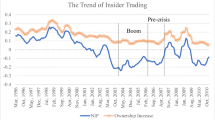Abstract
Real estate investment trust (REIT) provides a unique laboratory to study the relation between insider ownership and firm value. One, a REIT has to satisfy special regulations which weaken alternative mechanisms to control agency problems. Empirically, I find a significant and robust nonlinear relation between Tobin's Q and REIT insider ownership that is consistent with the trade-off between the incentive alignment and the entrenchment effect of insider ownership. Two, many REITs are Umbrella Partnership REITs (UPREITs) which have dual ownership structure. They have both common shares and Operating Partnership Units (OP units). Property owners can contribute their properties to the UPREIT in exchange for OP units. Their capital gains taxes remain deferred as long as they hold onto their OP units and the UPREIT does not sell the properties they contributed. OP units owners are locked in with the firm and have incentive to monitor firm management, but their interests diverge from the common shareholders because their tax bases are much lower. Consistent with the trade-off between positive monitoring effect of OP units and tax-induced agency costs, I find that UPREIT's firm value increases with the fraction of OP units, but the effect is significantly weaker for the UPREITs where insiders hold OP units.
Similar content being viewed by others
References
Ambrose B, Linneman P (2001) REIT organizational structure and operating characteristics. J Real Estate Res 21(3):141–162
Barclay M, Holderness C (1989) Private benefits from control of public corporations. J Financ Econ 25:371–395
Berle AA Jr, Means GC (1932) The modern corporation and private property. Macmillan, New York
Bhide A (1993) The hidden costs of stock market liquidity. J Financ Econ 34:31–51
Bradley M, Capozza D, Seguin P (1998) Dividend policy and cash-flow uncertainty. Real Estate Econ 26(4):555–580
Brickley J, Lease R, Smith C (1988) Ownership structure and voting on antitakeover amendments. J Financ Econ 20:267–291
Campbell R, Ghosh C, Sirmans CF (2001) The information content of method of payment in mergers: evidence from real estate investment trusts. Real Estate Econ 29(3):361–387
Capozza D, Seguin P (2000) Debt, agency, and management contracts in REITs: the external advisor puzzle. J Real Estate Finance and Econ 20:91–116
Chan SH, Leung WK, Wang K (1998) Institutional investment in REITs: evidence and implications. J Real Estate Res 16(3):357–374
Chan SH, Erickson J, Wang K (2003) Real estate investment trusts: structure, performance, and investment opportunities. Oxford:Oxford University Press.
Cho M-H (1998) Ownership structure, investment, and the corporate value: an empirical analysis. J Financ Econ 47:103–121
Demsetz H (1983) The structure of ownership and the theory of the firm. J Law Econ 26:375–390
Demsetz H, Lehn K (1985) The structure of corporate ownership: causes and consequences. J Polit Econ 93:1155–1177
Demsetz H, Villalonga B (2001) Ownership structure and corporate performance. J Corp Finance 7:209–233
Fama E, Jensen M (1983) Separation of ownership and control. J Law Econ 26:301–325
Friday S, Sirmans S (1998) Board of director monitoring and firm value in REITs. J Real Estate Res 16:411–427
Friday HS, Sirmans GS, Conver CM (1999) Ownership structure and the value of the firm: the case of REITs. J Real Estate Res 17(1):71–90
Ghosh C, Sirmans CF (2003) Board composition, ownership structure and performance: evidence from real estate investment trusts. J Real Estate Finance Econ 26(3), March 2003:283–314
Hartzell J, Kallberg J, Liu C (2005) The role of the underlying real asset market in REIT IPOs. Real Estate Econ 33:27–50
Hermalin B, Weisbach M (1991) The effects of board composition and direct incentives on firm performance. Financ Manage 20(4):101–112
Himmelberg C, Hubbard G, Palia D (1999) Understanding the determinants of managerial ownership and the link between ownership and performance. J Financ Econ 53:353–384
Howe J, Shilling J (1988) Capital structure theory and REIT security offerings. J Finance 43:983–993
Howe J, Shilling J (1990) REIT advisor performance. AREUEA Journal 18(4):479–499
Hsieh C-H, Sirmans CF (1991) REITs as captive-financing affiliates: impact on financial performance. J Real Estate Res 6(2):179–189
Jensen M (1986) Agency cost of free cash flow, corporate finance and takeovers. Am Econ Rev 76:323–329
Jensen M, Meckling W (1976) Theory of the firm: managerial behavior, agency costs, and ownership structure. J Financ Econ 3:305–360
Lang L, Stulz R (1994) Tobin's Q ratio, corporate diversification and firm performance. J Polit Econ 102:1248–1280
Lindenberg E, Ross S (1981) Tobin's Q ratio and industrial organization. J Bus 54:1–32
Loderer C, Martin K (1997) Executive stock ownership and performance: tracking faint traces. J Financ Econ 223–255
McConnell J, Servaes H (1990) Additional evidence on equity ownership and corporate value. J Financ Econ 27:595–612
Morck R, Shleifer A, Vishny R (1988) Management ownership and market valuation: an empirical analysis. J Financ Econ 20:293–315
Palia D (2001) The endogeneity of managerial compensation in firm valuation: a solution. Rev Financ Stud 14:735–764
Perfect SB, Wiles KW (1994) Alternative constructions of Tobin's Q: an empirical comparison. J Empir Finance 1:313–341
Sinai T, Gyourko J (2000) The asset price incidence of capital gains taxes: evidence from taxpayer relief act of 1997 and publicly-traded real estate firms. NBER Working Paper #7893, September 2000
Weston J (1979) The tender takeover. Mergers Acquis 74–82
White H (1980) A heteroskedasticity-consistent covariance matrix estimator and a direct test for heteroskedasticity. Econometrica 48(4):817–838
Wruck KH (1989) Equity ownership concentration and firm value: evidence from private equity financings. J Financ Econ 23:3–28
Zhou X (2001) Understanding the determinants of managerial ownership and the link between ownership and performance: comment. J Financ Econ 62:559–571
Author information
Authors and Affiliations
Corresponding author
Rights and permissions
About this article
Cite this article
Han, B. Insider Ownership and Firm Value: Evidence from Real Estate Investment Trusts. J Real Estate Finan Econ 32, 471–493 (2006). https://doi.org/10.1007/s11146-006-6963-8
Published:
Issue Date:
DOI: https://doi.org/10.1007/s11146-006-6963-8




